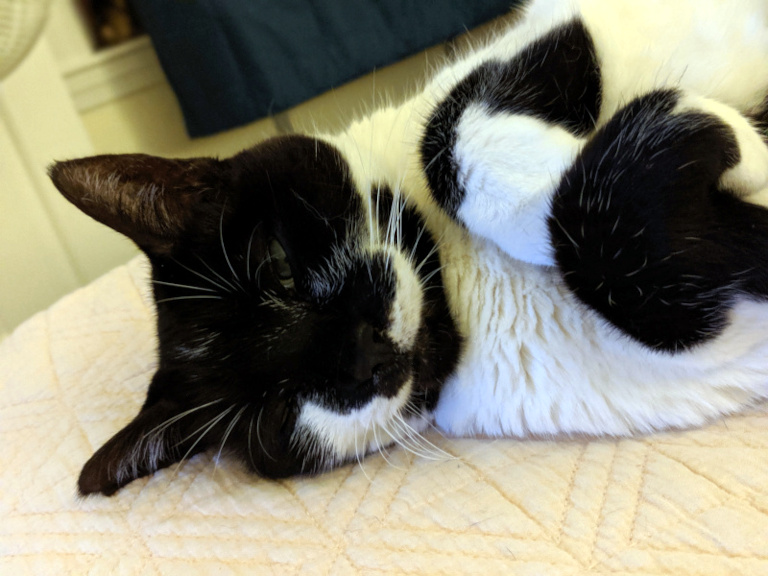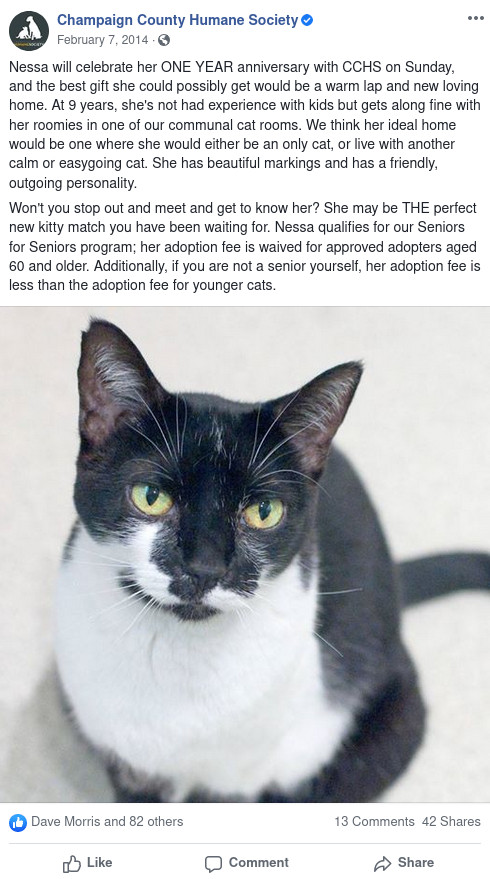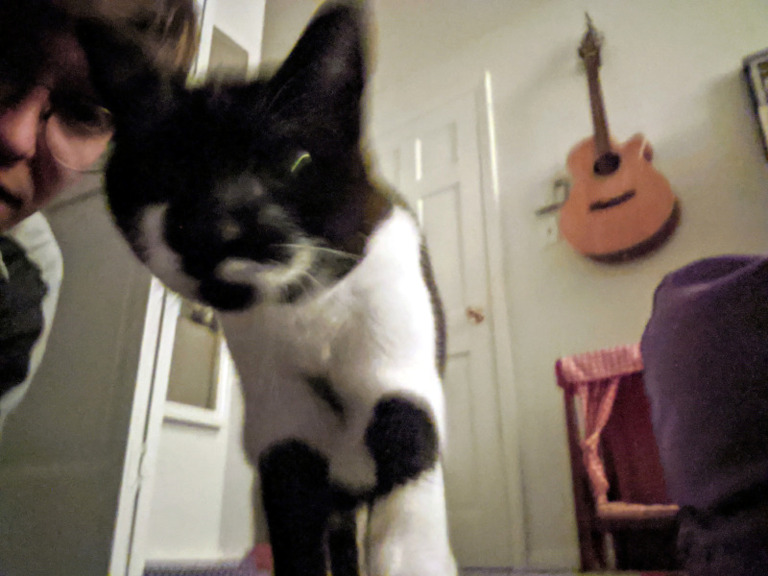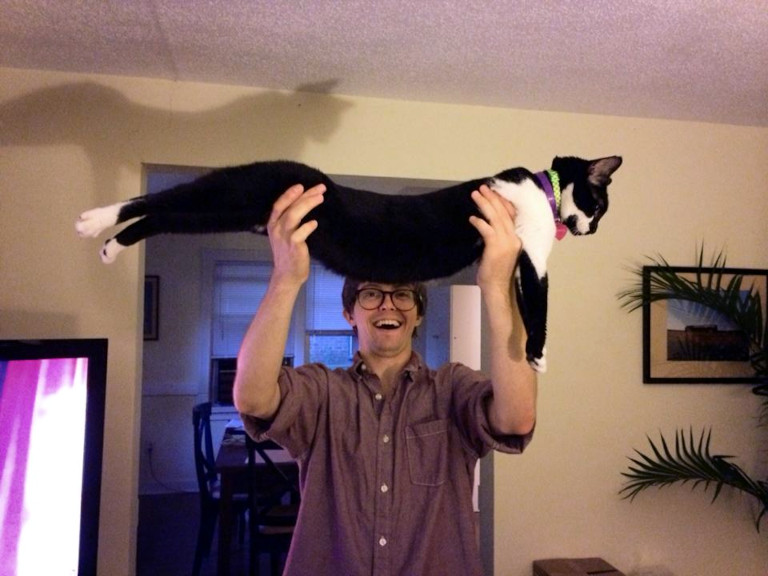Goodbye Numbers

We first met Numbers in July 2014. I had graduated college that spring, and my girlfriend Jami and I had moved just a week or two earlier from Massachusetts to Urbana, Illinois where I’d be starting grad school in the fall.
We already had one cat, Antigone (Tiggy for short), who I’d adopted a year earlier. We wanted another cat who Tiggy could play with when we weren’t around — we’ve since found out that, in general, as well as in our case, cats don’t want this. But we weren’t completely clueless. We had looked at cats in shelters in Massachusetts, but we knew that moving to a new apartment would be the best time to introduce the cats. We had already picked out a name. She would be called Numbers.
We met her at the Champaign County Humane Society in Urbana. They called her Nessa. She had been there since February the previous year, almost a year and a half, longer than most of the other cats there. She was living in a communal room — she was shy and scared when we approached her, but we asked to see her in a private room because she had been there so long. In the private room, her personality changed completely. She overflowed with affection — she was purring so loud, rubbing all over Jami and me, pushing her head into our bodies to demand we pet her. We filled out the form to adopt her.

We couldn’t take her home for a few days while the shelter confirmed with our landlord that we were allowed to have pets and completed whatever other administrative tasks they had to do. But we went and visited her the next day in her communal room. This time when we went in the room she ran up to us. She remembered us. I sat on something, a small bench, or maybe it was a cat tree, and she hopped on my lap and started purring loudly. She was probably kneading too — it’s a habit she would continue for the rest of her life. We were her people now. When any other cat approached us in the communal room she would make a frightened but aggressive high-pitch yowl. It frightened Jami and me.
We found out later from our vet that Numbers had been rescued from the home of an animal hoarder — she had seen her after the initial seizure. From her age and her time in the shelter, we guess she was probably in the hoarding home for eight years.
Numbers was a cat with a lot of trauma. She was perpetually anxious and scared. Any noise or sudden movement would make her jump. To her, the world was full of threats. She could respond in frightening ways. She was highly aggressive to other animals. Her shelter history contains a note from August 2013: “A couple adoption staff noted a cat fight yesterday night, but unable to determine which cats instigated the fight. Suspect Nessa.” Her aggression and violence towards other animals seemed to escalate when we were around. I think she had to fight to survive for those first eight years of her life. She was on her own until she found us, and then we became her most precious resource — she guarded us from all other animals. On a couple occasions seeing a cat outside of our window would send her into a violent fury of redirected aggression, attacking me or Jami, whoever was nearby, scratching and biting until we were able to confine her in a bathroom or trap her under a laundry basket.
We were never able to integrate Antigone and Numbers, despite years of trying. We would make some small steps forward, like feeding them in the same room, only to inevitably have a big fight wipe out all our progress. These weren’t little cat fights — when Tiggy and Numbers fought, it was to the death, teeth going straight to the throat, not stopping until we captured them under blankets and physically separated them into different rooms. There would be blood.
We resigned ourselves to keeping the cats permanently separated. And so Numbers, and Tiggy, and their shuffling became a structuring principle of our lives. One room in our apartments — we moved three times while we had Numbers — would always be closed off, keeping one cat away from the other. In Biddeford this was our bedroom; in Urbana, and now here in Old Orchard, it was our study. At dinner time we would swap the cats. The cat who was “out” would go in the bathroom; the cat in the closed off room would be freed. We’d swap the automatic feeders and the litter boxes — Numbers was on a special kidney diet most of the time we had her — and then stick the bathroom cat into the closed-off room. The past few months Numbers hasn’t had much of an appetite so we’ve been feeding her “out” every day to encourage her to eat — she would only really eat, lately, if someone was sitting with her.

Despite all of this, Numbers was an extremely social and loving cat, more so than I imagined any cat could be.
If I was home, Numbers would be near me. If I sat down, she would come to the couch and stare at the seat next to me, politely feigning little jumping motions until I patted the seat or my lap to consent. Then she’d hop on my lap and knead me, purring loudly. If she wasn’t around, I could whistle and she would come running — she preferred the melody to “Take My Breath Away,” or the X-Files theme song.
She loved to be pet, but only on the top of her head, cheeks, chin, and the top of her chest, which had her softest fur. Anywhere else she’d give your hand a quick nip to indicate no — unless, of course, she was sleepy and relaxed, in which case she tolerated pets further down her back, and maybe even a little on her belly. Her toes were always off limits, but I would still sometimes touch them, and she never held it against me.
She slept with us every night she was able to, always curling herself up against either me or Jami, or right in between us.
She had a habit of picking up toys and carrying them to us, screaming the whole way, and then dropping them on the ground a few feet from us. She only did this with a small subset of her toys, the “scream toys” — a small pink stuffed mouse, and a couple of green and purple stuffed toys.
She loved to go outside on a leash, a habit that made me anxious but that Jami, thankfully, encouraged, because it seemed to bring her so much joy. She loved to walk on the grass in our small back yard in Old Orchard and to lay in the warm sun.
She loved food, too, and would chase dry kibble, trying, usually unsuccessfully, to swat it out of the air as it was tossed over her. Sometimes we would give her a food puzzle, a purple plastic ball that you put dry treats or kibble in. It has a hole on the outside, and the cat has to bat the ball around to get the treats to fall out. Numbers quickly mastered the puzzle. We had to put tape over the hole to make it as small as possible so that she wouldn’t just instantly get all the treats.
Once, as I was bending over for something, she hopped from the floor onto my back and just stood on me. She jumped back down after a few precious seconds.

I am so grateful that I have been working from home these past few months and able to spend so much more time with Numbers. Jami made a little bed out of a box we found at Homegoods and a soft blanket and we put it on my desk, and every day that Numbers was in the study with me she would sleep on the bed all day as I worked, right next to my monitor; or sometimes she’d sit on my lap, poking her head into my video calls. I am so grateful that she was not alone in that room these past few months, and I know that she felt safer and happier having me there, and I felt safer and happier having her with me. She was an incredible companion and will always be a member of my family. Goodbye Numbers.